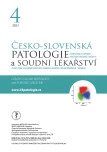Post-mortem examination of cases of sudden cardiac death. The Czech experience and the possibility of involving pathologists in a multidisciplinary process
Authors:
Alice Krebsová 1*; Štěpánka Pohlová Kučerová 2*
Authors‘ workplace:
za tým spoluřešitelů grantového projektu Ministerstva zdravotnictví ČR s reg. č. NV18-02-00237.
*; Centrum dědičných kardiovaskulárních onemocnění, Klinika kardiologie, IKEM, Praha
1; Ústav soudního lékařství LF UK a FN Hradec Králové
2
Published in:
Čes.-slov. Patol., 59, 2023, No. 4, p. 184-189
Category:
Original Article
Overview
Sudden cardiac death (SCD) in individuals younger than 40 years has a heritable cause in a significant subset of cases. Identification of SCD, postmortem genetic analysis along with the cardiological screening in first degree relatives represents an important tool for the primary prevention of cardiac arrest in victim´s relatives and requires multicentric and multidisciplinary collaboration.
Given that post-mortem examination is also recommended for individuals dying several hours to days after cardiac arrest, the role of autopsy performing specialists is one of the key ones in identifying the possible hereditary cause of sudden cardiac death.
Genetic stratification and identification of a certain hereditary cause of sudden death is generally achieved in about 20 % of cases, however, in families with a positive history of sudden death or heart failure and / or malignant arrhythmias, genetic testing is successful in up to half of the families. In the Czech Republic, a grant project succeeded in establishing multidisciplinary and multicentre cooperation. The results of the first Czech pilot study in the period from 2016 to 2021 correspond to the results of international studies and underlines the interest of relatives and the benefits for their health. The construction of an effective cardiogenetic network for the detection and diagnosis of cases of sudden cardiac death in the Czech Republic is still ongoing and the involvement of pathologist performing the autopsy would be of great benefit in this kind of diagnostics
Keywords:
prevention – genetic analysis – sudden cardiac death – inherited cardiovascular diseases –family cascade screening
Sources
- Goldstein S. The necessity of a uniform definition of sudden coronary death: witnessed death within 1 hour of the onset of acute symptoms. Americal Heart Journal 1982; 103(1): 156-159.
- Basso C, Aguilera B, Banner J, et al. Guidelines for autopsy investigation of sudden cardiac death: 2017 update from the Association for European Cardiovascular Pathology. Virchows Archiv 2017; 471(6): 691-705.
- Raju H, Parsons S, Thompson TN, et al. Insights into sudden cardiac death: exploring the potential relevance of non-diagnostic autopsy findings. European Heart Journal 2019; 40(10): 831-838.
- Stiles MK, Wilde AAM, Abrams DJ, et al. 2020 APHRS/HRS expert consensus statement on the investigation of decedents with sudden unexplained death and patients with sudden cardiac arrest, and of their families. Heart Rhythm 2021; 18(1): e1-e50.
- Kong MH, Fonarow GC, Peterson ED, et al. Systematic review of the incidence of sudden cardiac death in the United States. Journal of the American College of Cardiology 2011; 57(7): 794-801.
- Myerburg RJ, Junttila MJ. Sudden cardiac death caused by coronary heart disease. Circulation 2012; 125(8): 1043-1052.
- Myerburg RJ, Kessler KM, Castellanos A. Sudden cardiac death: Structure, function, and time-dependence of risk. Circulation 1992; 85(1 Suppl): I2-10.
- Priori SG, Blomström-Lundqvist C, Mazzanti A, et al. 2015 ESC Guidelines for the management of patients with ventricular arrhythmias and the prevention of sudden cardiac death: The Task Force for the Management of Patients with Ventricular Arrhythmias and the Prevention of Sudden Cardiac Death of the European Society of Cardiology (ESC) Endorsed by: Association for European Paediatric and Congenital Cardiology (AEPC). Europace 2015; 17(11): 1601-1687.
- Brinkmann B. Harmonisation of medico-legal autopsy rules. International Journal of Legal Medicine 1999; 113(1): 1-14.
- Basso C, Burke M, Fornes P, et al. Guidelines for autopsy investigation of sudden cardiac death. Virchows Archiv 2008; 452(1): 11-18.
- Stiles MK, Wilde AAM, Abrams DJ, et al. 2020 APHRS/HRS expert consensus statement on the investigation of decedents with sudden unexplained death and patients with sudden cardiac arrest, and of their families. Journal of Arrhythmia 2021; 37(3): 481-534.
- Fellmann F, van El CG, Charron P, et al. European recommendations integrating genetic testing into multidisciplinary management of sudden cardiac death. European Journal of Human Genetics 2019; 27(12): 1763-1773.
- Santos RD, Gidding SS, Hegele RA, et al. Defining severe familial hypercholesterolaemia and the implications for clinical management: a consensus statement from the International Atherosclerosis Society Severe Familial Hypercholesterolemia Panel. The Lancet Diabetes and Endocrinology 2016; 4(10): 850-861.
- Lahrouchi N, Raju H, Lodder EM, et al. Utility of Post-Mortem Genetic Testing in Cases of Sudden Arrhythmic Death Syndrome. Journal of the American College of Cardiology 2017; 69(17): 2134-2145.
- Lahrouchi N, Raju H, Lodder EM, et al. The yield of postmortem genetic testing in sudden death cases with structural findings at autopsy. European Journal of Human Genetics 2020; 28(1): 17-22.
- Wanner C, Arad M, Baron R, et al. European expert consensus statement on therapeutic goals in Fabry disease. Molecular Genetics and Metabolism 2018; 124(3): 189-203.
Labels
Anatomical pathology Forensic medical examiner ToxicologyArticle was published in
Czecho-Slovak Pathology

2023 Issue 4
Most read in this issue
- Flow cytometry immunophenotyping of the bone marrow samples for the diagnosis of hematologic neoplasms
- Fat-poor spindle cell lipoma: a case report
- The role of flow cytometry in the investigation of lymph node and extranodal lymphatic tissue specimen
- The role of flow cytometry in the diagnostics of pediatric haematologic and immunologic diseases
